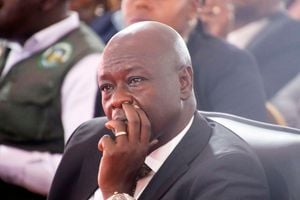-
Editions
-
ePaper
Hello
Your subscription is almost coming to an end. Don’t miss out on the great content on Nation.Africa
Ready to continue your informative journey with us?
Hello
Your premium access has ended, but the best of Nation.Africa is still within reach. Renew now to unlock exclusive stories and in-depth features.
Reclaim your full access. Click below to renew.
Happening Now: Earthwise Summit 2024
Nation Investigates
Eight hours of rage: How the Finance Bill 2024 led to storming of Parliament
By Mike Yambo, Illustrated by Geoffrey Onyambu
Published 3 October 2024
One hundred days ago today, something unprecedented in Kenya’s independence history happened: Parliament fell.
Like an elephant brought down by a thorn, the hallowed House on June 25, 2024 collapsed under the sting of unlikely ‘bees’ — GenZs.
While many an observer never saw this coming, signs of Parliament invasion were, for weeks, written all over the internet.
On social media, for instance, youthful Kenyans had expressed their unrelenting opposition to Finance Bill 2024, citing the punitive taxes and levies therein— including those imposed on cars, bread, sanitary pads, mobile-money transfer, vegetable oil, imported eggs, onions and potatoes.
In the proposed law, President William Ruto targeted to raise an additional Sh346 billion to finance his ambitious Sh3.9 trillion 2024/25 budget.
For weeks, Kenyan youth ardently expressed their outrage online, with significant social media mentions signalling contempt towards the bill, and elaborate plans to storm Parliament— telltale signs that Kenya’s intelligence seem to have ignored.
On X, the hashtag #OccupyParliament, alluding to a siege on Parliament, gathered more than 1.8 million mentions and 5.3 billion impressions between June 15th and July 19th, 2024.
#RejectFinanceBill2024, expressing discontentment towards the proposed law, had an engagement of over 52 million and 48 billion impressions, according to a Meltwater analysis conducted by Nation.Africa between June 16th and 28th, 2024.
On TikTok, within the same time, more than 17,000 posts had been attached to the hashtag #OccupyParliament.
However, when it became clear that the lawmakers were not paying attention to the online rage, the fury was transferred to the streets of Nairobi and 35 other counties of East Africa’s economic powerhouse.
But the first attempt to occupy Parliament had come a week prior— on the evening of June 20, when angry youths, who had staged a day-long protest in Nairobi’s Central Business District, pelted stones at structures and cars parked inside Parliament Buildings.
Their rock attacks were sparked by lawmakers’ decision to pass the bill during its First Reading.
But the full wrath of the protesters, whose grievances had been largely downplayed, would be felt a week later. Not even the warning by the then Inspector-General of Police Japheth Koome could stop them.
On the morning of Tuesday, June 25, a map showing the layout of Parliament Buildings was shared online.

Also shared were posters, dress code and plans for protesters’ movement that day.
These were some of the biggest indicators of the hell that was about to be unleashed on the House and the people’s representatives. The unthinkable was about to happen but again, the signs were ignored.
With live streams captured by protesters and posted on social media on June 25, Nation.Africa has used forensic analysis of the videos and photos to tell the complete story, for the first time, of what happened on the day Parliament fell.
The convergence
June 25, 8 am - 1 pm
A group of protesters gathers outside the Kenya National Archives, despite a strong presence of anti-riot General Service Unit officers in the area.
Meanwhile, inside National Assembly chambers, lawmakers assemble for the Second Reading of the Financial Bill 2024 at 9am. Unlike the usual Tuesday afternoon sessions, this sitting is scheduled for the morning.
Protest groups gain momentum, blowing whistles and waving Kenyan flags.
Voting on the proposed amendments to the Finance Bill 2024, as presented by members of Parliament and the departmental committees on Finance and National Planning, begins - the session is presided over by Deputy Speaker Gladys Shollei.
A growing number of protesters gradually gathers on Kimathi Street while chanting "We are Peaceful" slogans.
More agitated protesters stream into the CBD via Murang’a Road.
The police set up barricades on Thika Road to prevent passenger service vehicles from accessing the CBD.

Groups of determined protesters assemble on Kenyatta Avenue, as water-cannon trucks are deployed to manage the swelling crowd.
A protester is shot along Tom Mboya Street, behind the Kenya National Archives.
A group from Thika Road, where PSV vehicles had been barred from entering the CBD, is seen at Khoja Roundabout making their way into the city centre.
The large crowd on Kenyatta Avenue clashes intensely with the police, subsequently puncturing a water cannon truck.
The National Assembly approves amendments to Finance Bill in a record two hours. The deputy Speaker announces that the Committee of the Whole House has reviewed and nodded to the contested proposed law.
On the streets, protesters become increasingly agitated as police, who had run out of rubber bullets, use live ammunition.
National Assembly Speaker Moses Wetangula instructs the sergeants-at-arm to close the bars and lock the doors as the House starts voting by acclamation.
More protesters gather near All Saints Cathedral, with the crowd passionately singing along to a song playing on a public address system.
Crowds Grow
1 pm. - 2:11 pm.
The passage of the Finance Bill 2024 in the Second Reading ignites further outrage on the streets. A frustrated user on X expresses their determination to head to the Parliament Buildings.

Protesters flood the strategic streets of Nairobi's city centre, including Kenyatta Avenue and City Hall Way, chanting songs of liberation, solidarity and resilience.
Large crowds from All Saints Cathedral, Uhuru Highway, and Kenyatta Avenue converge, forming a single mass of protesters who clashed violently with the police. At this point, the police seem overwhelmed by the sheer number of charging demonstrators, and they gradually retreat from their defensive positions.
Protesters surge forward on Kaunda Street, compelling the police to abandon their defence lines and shift to Parliament Road due to the overwhelming numbers.
At the same time, on City Hall Way, police retreat as crowds from Moi Avenue and Kimathi Street march along Parliament Road.
The protesters stand about 200 metres from Parliament. At this point, the police have retreated and positioned themselves across Parliament Road to block access routes to the building.
Inside the National Assembly chambers, the voice vote concludes, and Mr Wetangula announces the final tally: 195 in favour, 106 against, 0 abstentions, and 3 spoiled ballots. A majority of lawmakers support the bill. But a few minutes later, several opposition members begin to walk out in protest, showing their discontent with the outcome. Tensions rise as the session continues.
Advancing toward Parliament territory
2:16 pm. - 2:46 pm.
By this time an approximated 237,680 protesters had shown up in major streets of Nairobi for the June 25 protest, according to an estimate by Mapchecking, a crowd-counting tool that fact checks the likely number of people in a given area.

An estimated number of protesters gathered on the major streets of Nairobi on June 25
About 200 metres from -Parliament Buildings, outside the Holy Family Basilica, a massive group clashes with a large contingent of police officers for the next 15 minutes. Despite the heavy gunfire, the protesters manage to push their way into Parliament’s territory.
The mob steadily breaks through police barricades, pushing back the officers as the charged protesters advance.
Satellite image of Parliament Road showing the position of protesters advancing towards the Parliament of Kenya
Opposition MPs march out of the National Assembly, exiting from the left wing of the Parliament building and heading toward the main gate, chanting, "Ruto Must Go!"
2:20 PM Opposition MPs walk out of the National Assembly
On the backside of parliament, where police presence is much smaller, another group of protesters attempts to enter the compound.
2:24 PM A group attempts to access Parliament via back fencing
For the next 10 minutes, heavy gunfire rends the air as police battle to keep protesters at bay. Meanwhile, a large group approaches the front gates of Parliament.
Violent confrontations break out between the officers and the crowd as rioters defy warnings of gunfire and gather at the main gate.
Inside the National Assembly chambers, lawmakers appear unsettled by the escalating violence, prompting the adjournment of the House session.
Storming the Parliament
2.46 pm. - 3 pm.
As clashes between police and protesters continue in front of the main gates of Parliament Building, another group charges at the fence on the right side of the compound, forcefully bringing it down and gaining access. At this point, a police truck is set on fire.
Inside the Parliament compound, police attempt to push back protesters with teargas, but a mob mentality has already taken hold. The rioters charge forward towards the Jomo Kenyatta Mausoleum, overpowering the police and breaching the building's outer perimeter.
A 3D illustration and video capturing the moment protesters advanced toward the right side of the parliament building.
More protesters approach the entrance of the building, pushing past the guards attempting to hold them back, and eventually breaching the right side of the building.
A 3D illustration and video capturing the moment protesters breached the right side of the parliament building.
Back at the front gates of Parliament, a livestream captures three protesters fatally shot and laying on the ground at a footpath.
A 3D illustration and video capturing the moment three protesters were shot outside parliament building
The Nation confirmed that two protesters, Erickson Kyalo Mutisya, 25, and David Chege, 39, were fatally shot by police outside Parliament Buildings. A third protester, Ian Keya, 26, sustained severe injuries to his spine and lost his limbs.



Violent clashes between the intruders and police continue for more than five minutes before the rioters finally break through and gain access to the building.
A 3D illustration and video capturing the moment protesters accessed the parliament building.
For 10 minutes, crowds roam the corridors of Parliament, moving to different sections of the building. Some gain access to the National Assembly chambers, while others enter the Senate chambers, all this while chanting "Ruto Must Go!"
At this point, MPs are evacuated from the premises through an underground tunnel that connects Parliament Buildings to Bunge Towers.
During this time, part of the building, the Senate, is set ablaze.
More than 10 minutes after the first rioters break into the building, some protesters leave through the main gates, carrying the National Assembly’s mace. They also help evacuate Nominated MP Jackson Kosgei, who was left stranded in his wheelchair, while chanting, "We are peaceful."
Outside the Parliament building on Parliament Road, the crowd grows as more protesters continue to arrive. At this point, there is no confrontation with the police.
In his presidential address later that evening, President Ruto described the actions of protesters, who had expressed their discontent with the tax-raising measures in the Finance Bill and whose concerns had been ignored for over two months, as "treasonous".
Methodology
The 3-D model of Parliament Building and movements inside is based on witness videos, photos and TV livestreams recorded from June 25. Nation.Africa used more than 100 verified videos to reconstruct the movement of protesters.
Credits
Production Editor: Harry Misiko.
Assignment Editor: James Smart.
Additional Report: Ndubi Moturi.
Thumbnail Illustration: Bilha Achieng.



